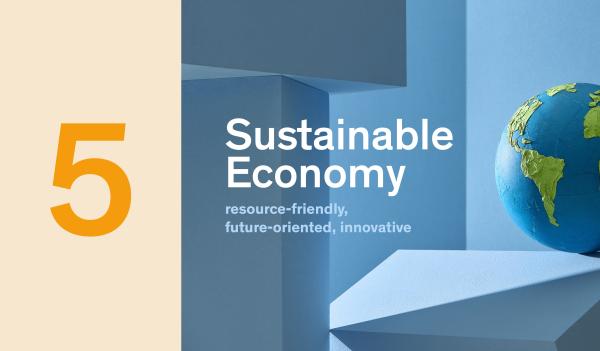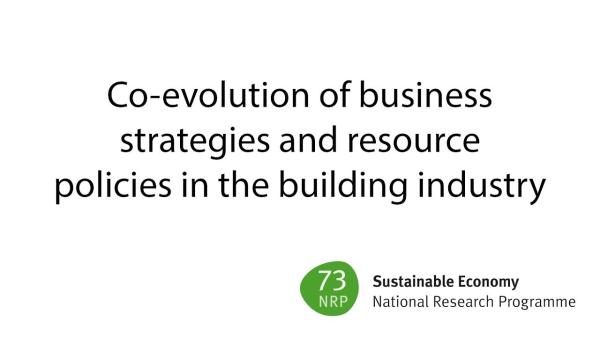Co-evolution of business strategies and resource policies in the building industry
As the construction industry uses large quantities of materials, politicians are creating a variety of incentives for recycling construction waste. In fact, the construction material cycle can currently not be closed, as the volume of construction waste being produced is much lower than demand. The gravel and concrete industry will be called upon to take steps in future, while politicians must create the necessary operating conditions.

Background
Mineral building materials such as gravel are a key domestic resource, but its use leads to considerable material turnover and transports. Closing the material cycles offers a solution for reducing both of these. Construction companies are thus becoming materials management service providers, and their sales/profit is becoming less dependent on raw material consumption.
The current shift towards a circular economy in the construction industry presents an opportunity here. This is being triggered by changes in political and legal operating conditions in various political areas, especially in waste management.
Aim
The project highlights how economic transition and changes in the legal and political environment can be coordinated more effectively. In this way we want to show people in political and administrative circles which measures and tools promote the circular economy in the construction industry and support the efficient use of mineral raw materials. Our results are intended to help construction companies develop their business models with a view to achieving a sustainable economy.
Results
The analysis of regional value chains for gravel and concrete shows construction planning and execution as a key process. This is where the most value added is created, where environmentally relevant decisions are taken and where the economic risks are the greatest. Many construction companies are therefore expanding their business strategies to include materials management (production, logistics, recycling and disposal).
The trend is strongest in densely built-up areas where construction activity is lively, as buildings are growing primarily in terms of height and depth. The volume of materials to be stored (excavation and mineral construction waste) in these regions exceeds demand for mineral construction materials. To date, however, only partial use is being made of this opportunity to develop a circular economy in the construction sector.
Overview of hindering factors
- Low storage volume lowers the price of gravel: As unsoiled excavated materials have so far been stored in empty gravel pits, the shortage of materials for storage results in low prices for gravel. There are therefore few economic incentives for producing recycled gravel by washing unsoiled excavated materials or recycling construction waste. At the regional level, a circular economy for mineral construction materials therefore presents no economic advantages.
- Interregional trade makes control more difficult: Any regional shortage of gravel or storage volume is offset by imports from other regions. Without political incentives, no circular economy can develop in regions with a shortage of raw materials or land reserves. Improved inter-cantonal coordination could greatly increase the effectiveness of the policies. Cantons/regions which currently have a strong gravel, cement and concrete economy could then play a key role in building up a circular economy.
- High risks hinder learning processes: The construction industry currently has high recycling ratios. If the volumes of mineral construction waste grow more strongly in future than demand for mineral resources, recycling of construction waste will become more demanding and more expensive. To prevent declining recycling ratios in this type of scenario, the currently fragile markets for secondary resources must be actively supported.
Implications for research
This project shows the benefit of model-based analyses as a tool in developing a regional circular economy. A dynamic system model and an evaluation model were developed together with stakeholder practitioners. The models allow areas for action to be prioritised, support negotiations between different interests and contribute to proactively balancing the undesirable consequences of individual policies. In this way, the project makes a major contribution to transdisciplinary research.
Implications for practice
The project illustrates areas for action and possible solutions for municipalities, cantons and the federal government. It shows how measures from various political fields can be coordinated, e.g. spatial planning and waste policy. The results support prioritisation of measures in terms of the desired effects (e.g. climate protection or regional business development).
The dynamic system model and the evaluation model can be used as prototypes to be developed into decision-making supporting tools in subsequent projects.
Publications
Project leaders
Prof. Dr. Susanne Kytzia
Institut für Bau und Umwelt,
Hochschule für Technik Rapperswil
Prof. Dr. Rainer Bunge
Institut für Umwelttechnik,
Hochschule für Technik Rapperswil
Dr. Katrin Hügel
Institut für Modellbildung und Simulation,
Fachhochschule St. Gallen
Dr. Christian Opitz
Institut für Operations Research und Computational Finance,
Universität St. Gallen
Alexander Scheidegger
Institut für Modellbildung und Simulation,
Fachhochschule St. Gallen
Project partners
Amt für Abfall, Wasser, Energie und Luft, Baudirektion des Kanton Zürich
Eberhard Group
Energie und Ressourcenmanagement GmbH
JMS Group
KIBAG
LafargeHolcim
Logbau AG
Merz Group
MOAG
Richi Weinigen
Spross Group
Toggenburger


